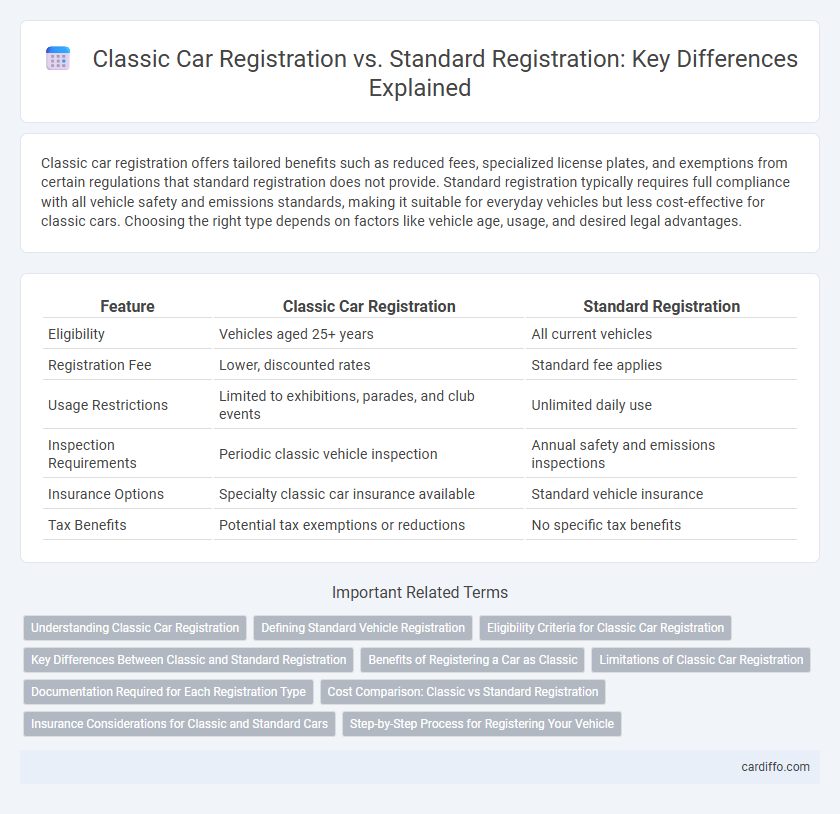Classic car registration offers tailored benefits such as reduced fees, specialized license plates, and exemptions from certain regulations that standard registration does not provide. Standard registration typically requires full compliance with all vehicle safety and emissions standards, making it suitable for everyday vehicles but less cost-effective for classic cars. Choosing the right type depends on factors like vehicle age, usage, and desired legal advantages.
Table of Comparison
| Feature | Classic Car Registration | Standard Registration |
|---|---|---|
| Eligibility | Vehicles aged 25+ years | All current vehicles |
| Registration Fee | Lower, discounted rates | Standard fee applies |
| Usage Restrictions | Limited to exhibitions, parades, and club events | Unlimited daily use |
| Inspection Requirements | Periodic classic vehicle inspection | Annual safety and emissions inspections |
| Insurance Options | Specialty classic car insurance available | Standard vehicle insurance |
| Tax Benefits | Potential tax exemptions or reductions | No specific tax benefits |
Understanding Classic Car Registration
Classic car registration differs from standard vehicle registration by offering specialized benefits tailored to vintage automobiles typically over 25 years old, including lower fees and limited usage allowances. Understanding classic car registration involves recognizing eligibility criteria such as vehicle age, condition, and usage restrictions that distinguish it from regular registration requirements. This registration type often provides exemptions from emissions testing and reduced taxation, making it a cost-effective option for collectors and enthusiasts preserving automotive history.
Defining Standard Vehicle Registration
Standard vehicle registration is the legal process of recording a vehicle with the relevant transportation authority, allowing it to be driven on public roads while complying with safety and emissions regulations. Unlike classic car registration, which often applies to vintage vehicles meeting specific age and usage criteria, standard registration covers everyday passenger cars, trucks, and motorcycles used for regular transportation. This process includes providing proof of ownership, paying registration fees, and obtaining license plates and vehicle tags valid for a designated period.
Eligibility Criteria for Classic Car Registration
Classic car registration eligibility typically requires the vehicle to be at least 20 to 25 years old, maintained in original or historically accurate condition, and used primarily for exhibitions, club activities, or similar events. The vehicle must often have a clear title and pass specific inspections to verify its vintage status. Standard registration applies to all other vehicles without age or usage restrictions but usually involves higher fees and more comprehensive regulatory compliance.
Key Differences Between Classic and Standard Registration
Classic car registration typically applies to vehicles that are at least 20-25 years old and often includes benefits such as reduced fees, usage restrictions, and special plates reflecting the vehicle's vintage status. Standard registration covers everyday vehicles with no age restrictions, requiring regular fees, insurance, and compliance with current emission and safety standards. Key differences include eligibility criteria based on vehicle age, cost structure, and permitted vehicle use, with classic registration aimed at preserving historical vehicles while limiting daily on-road operation.
Benefits of Registering a Car as Classic
Registering a car as classic provides benefits such as reduced registration fees, exemption from certain emissions tests, and eligibility for specialized insurance rates. Classic car registration often limits annual mileage, ensuring the vehicle is preserved and maintained as a collector's item. This status can increase a car's resale value and grants access to exclusive events and clubs tailored to vintage automobile enthusiasts.
Limitations of Classic Car Registration
Classic car registration often restricts vehicle use to limited driving activities such as exhibitions, club events, and maintenance trips, prohibiting daily commuting or commercial purposes. These limitations also include mileage caps that vary by state, commonly around 2,500 to 5,000 miles annually, which might not align with regular driving needs. Standard registration imposes fewer usage restrictions, allowing unrestricted daily operation and broader insurance options.
Documentation Required for Each Registration Type
Classic car registration requires specialized documentation including proof of vehicle age, typically 25 years or older, and evidence of the vehicle's historic or collectible status, such as a classic car appraisal or membership in a classic car club. Standard registration mandates submission of the original title, proof of current insurance, a valid driver's license, and a completed application form, along with payment of registration fees. Both registration types generally require a vehicle identification number (VIN) inspection and emissions test results, but classic car registration often has exemptions regarding emissions or usage restrictions.
Cost Comparison: Classic vs Standard Registration
Classic car registration typically costs less annually than standard vehicle registration due to lower fees and reduced taxes, reflecting the limited use and older age of classic cars. Standard registration fees are generally higher as they account for more frequent vehicle use, higher vehicle value, and stricter emissions compliance. Evaluating state-specific fee schedules shows classic car owners save significantly on registration renewal compared to standard vehicle owners.
Insurance Considerations for Classic and Standard Cars
Classic car registration often requires specialized insurance policies that account for limited mileage and vehicle value, providing tailored coverage and potentially lower premiums. Standard car registration typically involves regular insurance plans based on the vehicle's current market value, usage, and driver profile, often resulting in higher premiums due to everyday risk factors. Insurers assessing classic cars emphasize preservation and usage restrictions, while standard car insurance prioritizes comprehensive coverage for routine driving and broader risk exposure.
Step-by-Step Process for Registering Your Vehicle
Registering a classic car involves gathering specialized documentation such as proof of authenticity and builder's certificate, then submitting it to the DMV with the appropriate classic car application form, while standard registration requires a valid title, proof of insurance, and emissions test results. Both processes mandate payment of registration fees and obtaining license plates, but classic cars often have additional requirements like mileage limits and usage restrictions. Following the exact step-by-step guidelines specific to classic or standard registration ensures compliance and smooth vehicle registration.
Classic Car Registration vs Standard Registration Infographic

 cardiffo.com
cardiffo.com